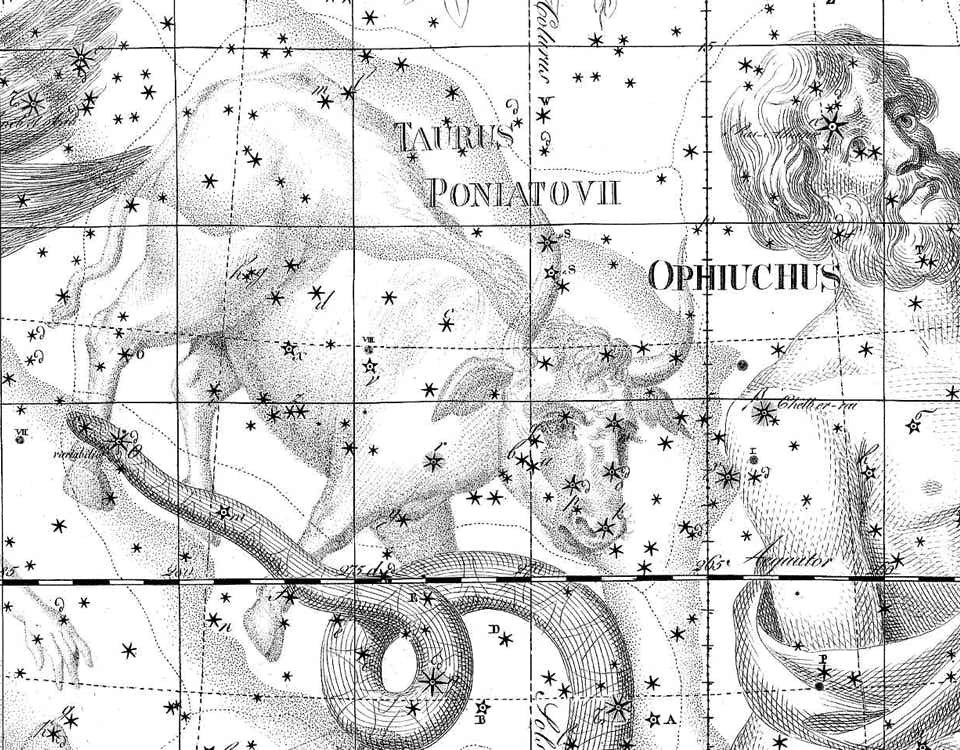
This constellation, tucked awkwardly between Ophiuchus and Aquila and overlapped by the tail of Serpens, was originated in 1777 by Martin Poczobut (1728–1810), director of the Royal Observatory at Vilna (now Vilnius, Lithuania). He invented it to honour his king, Stanisław August Poniatowski, who was monarch of both Poland and Lithuania. King Stanisław was a noted patron of the arts and sciences, and the bull was a feature of his family’s coat of arms.
The face of the little bull was formed by a V-shaped group of stars between the right shoulder of Ophiuchus and the tail of Serpens. This group reminded Poczobut of the Hyades cluster that outlines the face of Taurus the bull in the zodiac. Five of these had been listed by Ptolemy as ‘unformed’ stars outside Ophiuchus; they are now known as 66, 67, 68, 70, and 72 Ophiuchi. The last star listed by Ptolemy lay on the bull’s right horn and was the brightest star of the constellation, magnitude 3.7. These unformed stars can be seen, for example, on Albrecht Dürer’s star chart of 1515. The rest of the body was fleshed out by fainter stars.
Taurus Poniatovii, overlapped by the tail of Serpens, the serpent, pictured on Chart IX of the Uranographia of Johann Bode (1801). The face of the bull is marked by a V-shaped group of stars reminiscent of the Hyades cluster in Taurus, the zodiacal bull. This same group of stars had previously been incorporated in another figure, Tigris, which was already abandoned by Poczobut’s day.
Poczobut published a catalogue of 16 component stars in Cahiers des observations astronomiques faites à l’observatoire royal de Vilna en 1773 (published 1777). This list was reprinted for wider consumption by Johann Bode in his Astronomisches Jahrbuch (Astronomical Yearbook) for 1785. The constellation was first depicted in 1778 as le Taureau Royal de Poniatowski in a revised reprint of Jean Fortin’s Atlas Céleste (confusingly, this revised version still carried the original publication date of 1776). Bode later Latinized its name to Taurus Poniatovii on his Uranographia atlas of 1801 (see illustration above).
Poczobut did not realize it but his short-lived creation contained the faint red dwarf known as Barnard’s Star, which we now know to be the second-closest star to the Sun, 5.9 light years away. It lay in the bull’s head, near the present-day 66 Ophiuchi. Sadly, Poniatowski’s bull did not last long in the sky before being put out to pasture and its stars are now part of Ophiuchus and Serpens Cauda.
© Ian Ridpath. All rights reserved
Ptolemy’s five unformed stars lying outside Ophiuchus from which Taurus Poniatovii was formed, seen on Albrecht Dürer’s northern celestial chart of 1515. The stars are numbered from 1 to 5, which was the order in which they were listed in the Almagest. The modern designations of these five stars are 66, 67, 68, 70, and 72 Ophiuchi. On this chart the constellations are reversed left to right as on a globe, so the stars appear to lie above the right shoulder of Ophiuchus rather than the left. See also Ptolemy’s spare stars.




